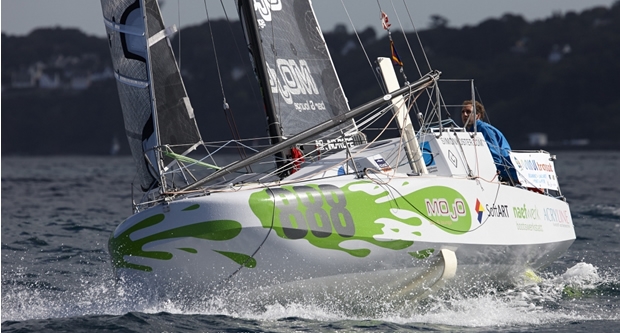
The semi-flying Mini scow
Once upon a time there was the vague theory in yacht design that if something ‘looked right’ it probably ‘was right’. Okay, this may have been said by an old guy, wearing an oiled wool jumper and smoking a pipe… However the latest ideas in offshore yacht design, combined with the box rule for the Mini Class, has created a yacht that defies this in every way.
The writing was on the wall following the performance of David Raison’s Magnum scow that won the 2011 Mini Transat. An upgraded version of the Magnum, Davy Beaudart's Flexirub is favourite for line honours in the 2015 Transat’s Proto class. However Simon Koster’s Eight Cube has taken the scow concept much further.
Continuing the tradition of sailors from land-locked Switzerland being outstanding offshore racers, Koster competed in the last Mini Transat finishing third in the Series class (and directly behind fellow Swiss sailor and Team SCA crewwoman Justine Mettraux). However for this year’s race he wanted to sail a boat that would push the limits of yacht design.
“I talked to a lot of designers before I started the project and no one could really tell me which way they wanted to go – but typically they don’t say a lot before you actually commit to go with them,” recounts Koster.
He says his first thought was to go with David Raison, but he had just designed Flexirub and at the time couldn’t come up with anything much better. “I didn’t really like that idea,” continues Koster. “I wanted to sail a Proto, because I want to try some new things and to try to go a little further than what has been done before.
“I really like the technology. I think, especially this year, there is a good fleet in the Protos, where quite a few have done the race before in Series boats and have come across – which wasn’t the case in the last few years. All the last generation boats are sailing again this time, either repaired or sold to new guys.”
On the last Mini was Julien Marcelet, who was an engineer working for Michel Desjoyeaux’s design company Mer Forte and he and Koster talked ultimately leading to Mer Forte being given the green light to come up with their interpretation of a state of the art Proto Mini. MichDes was involved in the early work on the boat before heading off to do the Volvo Ocean Race, and subsequently also contributed greatly to the design of the systems, says Koster.
Designing a scow Koster maintains was an obvious first step, after they had all seen how effective it was. However the Mer Forte scow appears to have a shallower forefoot than the Magnum, an effect (with her white/green paintjob) that makes the boat look like a frog, whereas the bow shape of the David Raison design is more sperm whale.
“Then the question was ‘what can we do on the appendage side?’ Nothing has been done for a long time in terms of developing profiles or what can be done with rudders and lift, etc. So we decided to go down the route of actually putting foils on the boat. We can’t do it like the IMOCA 60s because we can’t go out of the topsides yet, but we are much freer – we can move them in any direction we want and we’re not restricted to five appendages. Some old Minis had downwind daggerboards positioned in the cockpit, for example.”
So Koster’s Eight Cube has a canting keel, which is telescopic – a brilliant, but not a new idea in the Mini class – that causes his boat’s keel foil to retract to within maximum draft when it is vertical, but then to extend as the keel is canted (her keel cants to 37°), while still remaining within maximum draft. This is also used on the keels on the Magnums, and allegedly it was first tried on Mini hull no 198. Koster admits that this was probably the most complex feature of his complex boat.
And Eight Cube’s keel has yet more functionality…as Koster explains: “We use the fin of the keel to create some lift as well. The back bearing moves by 30mm sideways, which means that when the keel is canted it is like putting tilt on the keel.” So a similar effect to having a trim tab on the keel foil? “Yes, but not as effective because, it still has a symmetric profile, but it was easier to do - it would have been difficult to put a trim tab on the telescopic keel. Also it is just easier to move like this while making it flush to bottom of the boat so that is clean.”
Then there are the foils. Unlike the IMOCA 60 L-foils that protrude from the topsides, this is prohibited by the Mini's maximum beam limit, so instead Eight Cube’s foils are effectively vertical daggerboards but with an inward pointing tip on them, measuring around 700mm long and following a similar curvature of the bottom of the hull, to get them out of the water as much as possible when they are up to weather.
Also forbidden on the IMOCA boats, the rake of Eight Cube’s daggerboard/foils can be altered via a worm drive in a similar fashion to the mechanism on the GC32 catamaran. And, in case you are wondering, the foils are located just forward of the keel, so there are no issues with foils and keel colliding.
A similar arrangement allowing adjustment of the rake of the inverted T-foil rudders was considered however as Koster says it was too complicated. Now the rudder T-foils are effectively fixed although it is possible to alter their rake by padding out the bottom bracket with chocks. “It is not easy to do and you’d have to slow do a bit to do it and then get going again,” he says.
At present the foils start working in more than 10 knots of boat speed and reach their optimum performance at around 14 knots. At this point they are developing around 500kg of lift or around 60% of the boat’s 800kg displacement (although it is still very early days with his studies into this). “Then you get the [keel] fin which starts to work as well to create some lift. That is what most of the boats do already – they start to fly on their keel.”
So if you’re getting lift from all the foils, isnt' the giant hull just righting moment greed? “It is still an offshore boat, so you need to have an all-round boat. It needs to be light, that’s for sure, but not skinny because you want to have your foil as far out as possible because otherwise, especially with the foils going inwards, you’ll lose righting moment.”
One advantage of Eight Cube’s foil arrangement over that of the IMOCA 60s is that because the foils are effectively vertical daggerboards with tips, they perform as well as they always have done upwind, albeit with some additional drag. Downwind the way the foil is used is slightly different from conventional daggerboards. On conventional canting keel boats the leeward board is mostly retracted, but on Eight Cube the foil needs to remain deployed.
And how about running properly downwind with both foils deployed? “That could work - the problem will be what happens in between the foil and the keel,” says Koster. “I haven’t been out in enough breeze to fully test that yet.”
So what it is like to sail? “It takes a bit of getting used to, not seeing the bow or the waterline to see how the boat is in the water. Then the other thing is that you can feel when you use the foil that it pushes quite early on even when you are not going that quick. And the bow is further up than normal, but it is hard to know where you are actually at because you can’t actually see!
“And you have to be careful not to use the foil too early because it is too much drag. It is not always easy to figure out what is actually controlling the stability of the boat – is it the foil, the keel or the angle on the rudders or is it the mast rake as well, which comes into play?”
Coming from the Series boat, even the beamy Nacira, Koster says that the added stability of his new boat is noticeable. “But the movement of the boat is violent and it accelerates quickly and it stops quickly. That takes some getting used to.”
The scow shape he says is not too bad upwind, but “if there’s light air or chop, that is when it gets complicated. If it is normal wind, or the wind with the waves, then it is alright, that works because there is a lot of power in the boat, so you punch through it. She doesn’t go as high as the older boats, but she goes very quick.”
Also unusual is Eight Cube’s Finot Hugo Boss-style twin cabintops. While other skippers have been wetting their lips at the idea of possibly standing headroom down below (looks be damned), it does (as it did on Hugo Boss) provide a convenient, waterproof, means of getting lines aft to the cockpit from the mast. However according to Koster, the principle reason for the somewhat ugly cabintops is to add buoyancy in the Mini’s mandatory 90° inclination test. As a result it is possible to fit a heavier bulb or to cant the keel further.
As ever with such a complex boat, it remains a work in progress. The boat was only launched at the end of May and entered the Mini Fastnet when the keel axle broke. “Then it was back to the yard for three weeks and then down to Barcelona to qualify there.”
“It will take some more time to get to the boat’s full potential. Every time I go out sailing I come back with the feeling that I’ve learned something and the boat is going quicker than it went before. It is cool to be able to go out and be able to make progress so quickly.”
And wonders the future of a boat such as this with Classe Mini having agreed to permit in the next cycle, a maximum beam of 6m (but 3m still on the start line). This will effectively legalise the use of DSS-style lateral foils in the Mini.
Our tech shots
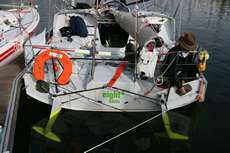 |
 |
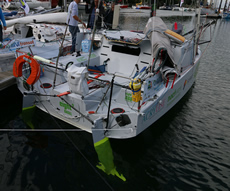 |
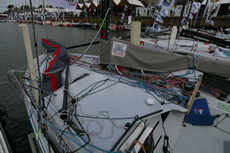 |
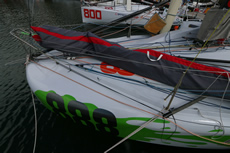 |
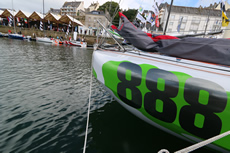 |
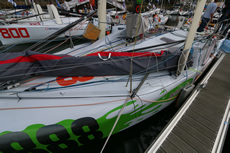 |
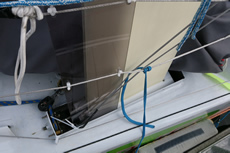 |
 |
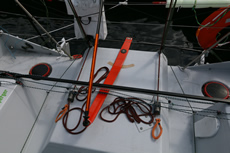 |
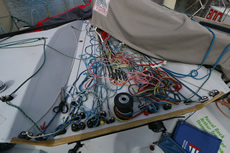 |

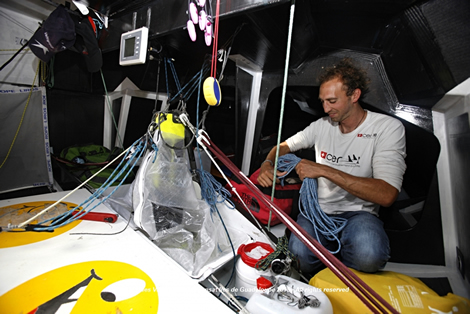
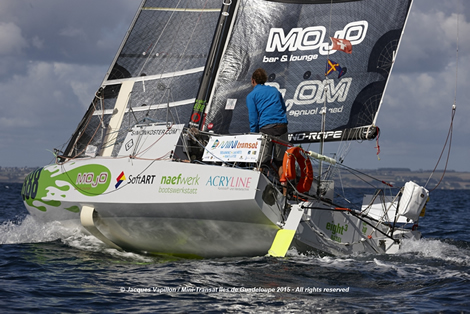
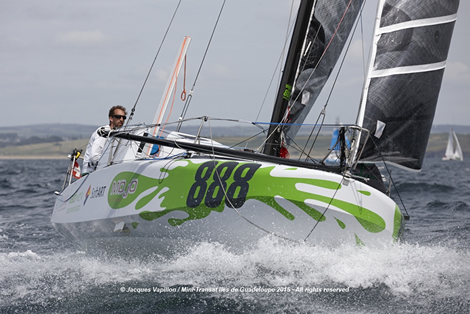








Latest Comments
Add a comment - Members log in